How to evaluate IP address assignment for cable modem, xDSL and Home LAN
KRNIC Policy Development and Research Division
I. Introduction
By providing high-speed and low-priced Internet connection technology through the explosive expansion of Internet and development of the related technology, the existing dedicated line services are turning rapidly into end-user-oriented services.
Representative services such as xDSL or cable network, are the typical ones that don't charge a burden of phone call expanses and have a strong advantage which is known as a high-speed Internet with no extra-charge of money for 24 hours.
This kind of advantage contributes extensively to the rapid expansion and activities of Internet, but xDSL and cable lines that provide 24 hrs on-line services, would need the IP address as many as those number of xDSL and cable line subscribers.
According to the goals of international Internet address space management policies that are Uniqueness, Registration, Aggregation, Conservation, and Fairness, it is judged to be necessary to own a proper management guiding principle as a response to the each service in order to actively deal with the demand of IP address for a rapid expansion of xDSL and cable network, using IPv4 addressing method that is currently facing the imminent crisis of exhaustion of the limited IP address resources.
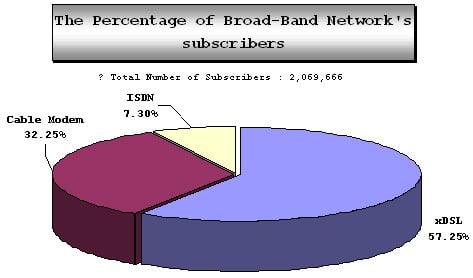
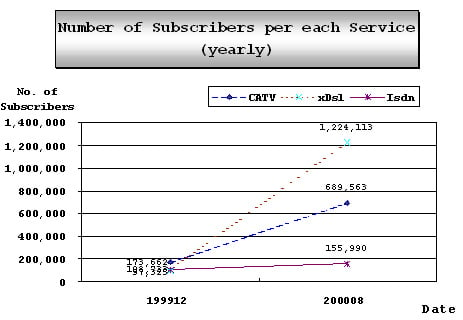
II. Problems
1. The necessity of assigning IP addresses in the ratio of 1:1 basis for each subscriber.
As previously mentioned in the beginning, these kinds of services, xDSL and cable network are being used in the form of dedicated line as the permanent connection. In real situation, those ISPs in Korea who provide services like xDSL and cable network assign dynamic IP addresses using DHCP. But, due to the characteristics of these low-priced and high-speed services, most of the subscribers would need IP addresses as 1:1 basis since many subscribers show a tendency of leaving computers on for all day around, as connected to Internet.
2. Difficulty of evaluating IP address usage and determining how many additional IP addresses would be allocated in the future.
At the present time, the IP address spaces are allocated to most of the ISPs on the basis of an estimated figure in prospective subscribers who are considered as future business target. Each time, the way of allocation is done after analyzing and predicting the subscribers' number in six month and one year. But, the target of each corporation is merely a pre-estimate, and there can be differences from the actual subscriber numbers later on. As a result of that, the present IP address allocation method is currently in a vague and uncertain stage.
As a conclusion, The problem for allocating IP addresses according to the present registration policy, can be resolved only when clear and transparent procedures and policies in terms of an initial and later on allocations are provided.
3. No guideline in registering end-users' information into Whois database.
There can be two IP address assignment method, dynamic and static assignment. But, both methods have certain problems in registering end-users information. For example, the proliferation of network warfare like spam mail or hacking in today's world through such services like xDSL and cable network is becoming the serious issue in Korea.
In case of dynamic end-users' assignment, problem is that dynamic IP addresses are merely being considered as a related ISP's network infrastructure. For instance, when one end-user needs an IP, the network infrastructure gives out an arbitrary IP from a certain assigned range for that immediate use. Therefore, it will be impossible to have a quick and prompt confrontation for such spam mail attack or hacking incidents since only the related ISP's information and assigned address range are being registered in Whois database.
In case of static end-users' assignment, it uses IP unnumbered. Even when assigning one IP address (/32), each IP address user's information has to be registered in Whois database. In such case, it would be a very difficult task for ISPs to register over 2 million-users' information. In addition to that, there are many users who frequently change service providers so as to meet their satisfaction. So, it would be extremely difficult to keep and manage a precise users' information. To say it further, since most of the users are private individuals, it could violate the private information protection law, upon providing each individual's information.
III. Current Practice at KRNIC
A. Cable network
1) Illustration of Cable network - Sourced by THRUNET

- It needs Static Assignment allocation
- It needs to allocate IP addresses in the ratio of 1:1 basis for each subscriber
2) KRNIC guidelines for IP address assignment for cable network
- If an organization that owns a network of dedicated line system wants to have an additional Internet connection using cable modem, then they wouldn't need to be evaluated since there is a previously assigned IP address to the relevant ISP.
- We consider, Internet connection using cable line is totally a separated network.
- "An ISP must receive IP address from only one upstream provider", this policy does not affect to the cable network case.
- If DHCP is possible in 2-way cable connections, then the ISP must consider using the DHCP. On the other hand, one-way cable connections with conventional dial-up access using one-way traffic, can be assigned statically. If there is any equipment that does not support DHCP, then the ISP must provide relevant information of that equipment such as manufacturer's name, model name, specification etc. so as to explain the reason.
- For the cable network, static IP address assignment is allowed. But, for the static assignment, ISPs must provide clarifications why they have to assign IP in that way.
- For static IP assignment:
- In case of one-way cable connections with conventional dial up or other methods, the ISP can assign IP address statically.
- The ISP must provide a detailed network description including current network topology, characteristics, model number of each equipment, trend of increasing subscribers, and statistical analysis for the IP address usage and etc. These informational documents must fulfill the needs of understanding why static allocation is necessary.
- If any subscriber request static IP, then the ISP must maintain the user's information. When KRNIC or APNIC requests the end-user's information, the ISP must provide the information immediately.
3) Evaluation and registration of end-user's information
- Dynamic IP address assignment:
- - Register the "INETNUM" object for each logical cluster (local node or POP) as Infrastructure
- Static IP address assignment:
- - For the registration of end-user's information in static assignment, the ISP can choose one of the following,
In each assignment, end user's information must be registered into KRNIC Whois database using the form "Requesting IP address for the end-user"
Or
ISP must provide the entire end-users list to KRNIC using the following format:
- End-user/ISP, starting number, length, address, telephone #, Email
- - For the registration of end-user's information in static assignment, the ISP can choose one of the following,
4) When the ISP return to KRNIC for additional IP address space
- The ISP must provide subscribers' estimate for next 3 month. Then, KRNIC will evaluate their request and decide what size of IP address space should be allocated. The size may differ from what they originally requested. Reason is that the pre-estimate is only a prediction, not actual data. So, KRNIC just refers the estimated data and check the history of how many blocks they have received each time. In addition, it examines how soon the ISP returns to KRNIC for the additional IP address and actual data of the growing subscribers.
- KRNIC allocates IP addresses according to the demonstrated utilization. This utilization is based on the number of the ISP's logical clusters and number of subscribers growing in a certain period.
- The ISP must provide how many IP address spaces have been assigned to each logical cluster including the actual IP address's starting and ending number. In addition, the ISP must submit the list of subscribers.
B. xDSL
1) Illustration of xDSL Network - Sourced by HANARO Telecom
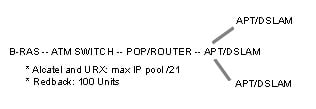
2) Pattern of IP address assignment for xDSL
- It assigns IP addresses dynamically using DHCP. Ratio of subscribers and IP addresses is 2:1, but in many cases, it needs 1:1 basis.
- Guidance
- Since it is assigned dynamically, register the assignment information as ISP's infrastructure.
- Decision in the size of IP address spaces is made through the current condition of the ISP's number of subscribers up until now, and facilities investment needs to be made.
- IP address's assigning management differentiates through the local node unit. It periodically reports current number of subscribers and assigned IP addresses.
3) Method of assigning registration
- Static IP assignment
- It registers a user or the related agency's information for each static allocation.
- Mirroring
- Expected to be installed in a near future
- End-user's information that assigns IP address statically, must keep the information in the relevant ISP's public database. Each day KRNIC will do the mirroring for all end-users' information using its own WHOIS database
- Dynamic IP assignment
- It registers as infrastructure for the itemized assignment of each local node unit
C. Home LAN
Definition
Home LAN service is slightly different from xDSL. It is structured that each subscriber uses LAN format and each apartment or building complex setup a router so as to form an independent network.
Illustration - Sourced by HANARO Telecom
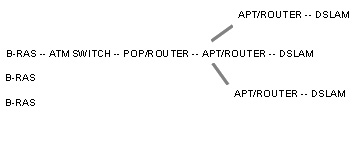
Registration of IP address allocating information for each individual network (Apt. or Building)
Initial IP address assignment and reliable source for additional allocation
- Initial allocation is /27
- Additional allocation needed as the subscribers increase, ISP must provide following data
- List of subscribers
- Usage rate of IP addresses: a current condition of PING or Max IP address occupancy rate.
IV. Conclusion
KRNIC would like to propose that for a smooth IP address allocation and efficient Internet address management for ISPs, we would need
A precise definition of Infrastructure and Customer network
Following are the list of formalized and documented materials that are clear and justifiable, for review and evaluation.
Summary of IP address usage and the number of subscriber
- This data can show usage rate of each local node
Node Subscribers Number of Port Total Usage Rate(%) Seoul 800 800 /23+/24 90% Pusan 250 500 /24 70% The status of IP address assignment per each node
Node IP address space Total Sub Total Date of Assignment Seoul 210.100.32.0 ?210.100.32.255
210.100.36.0 ?210.100.36.255
210.100.52.0 ?210.100.52.255/24 /24 /24 /23+/24 2000.1.1
2000.2.15
2000.4.20Pusan 210.203.22.0 ?210.203.22.128 /25 /25 2000.3.6 Total /23+/24+/25 List of data to be presented for smooth IP address usage rate verification.
MRTG data
This one below is one example of MRTG Report to verify the number of users. We can see that the MRTG Report can help us to analyze how many IP addresses are actually assigned to subscribers.
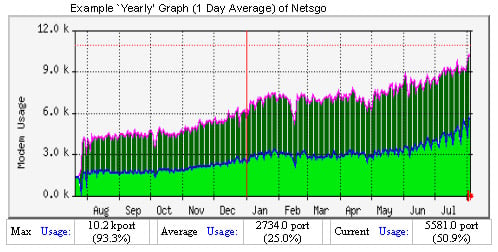
Ping data
The history of subscribers' growth rate and the list of reserved subscribers
For the concrete procedures to achieve efficiently assigned IP address spaces for end-users of each service, we needs to decide the structure of possible minimum size of assignment for the expected subscribers or equipment.
Our finalized approach to each service
Cable network
Assign /24 per CMTS equipment and CISCO-ubr 7 units Max bundling Ex) THRUNET uses 4 cards per each CISCO-UBR. Here, and they use Bundling Cable Interfaces feature that allows multiple cable interfaces to share a single IP subnet, so as to get the best network traffic control. In this case, THRUNET assigns /24 per CMTS.
Assign additional /24 when monitoring shows 85% - 90% in MRTG Report. As told before, since we cannot obtain exact estimate or prediction, it is recommended that additional /24 is to be allowed when number of subscribers increase.
If more than 250 persons, then assigning /23 is suitable.
xDSL
Assign /24 with each B_RAS equipment unit and minimum allocation pattern.
If 70% of assigned /24 is occupied, then assign additional /24
Home LAN
Initially assign /27 to each home LAN segment.
Since Home LAN is more like an independent network with small number of people, it is recommended that /27 is initially being served.
| Summary | ||
| Initial Assignment | Additional Assignment | |
| Cable network | /24 (1 C class) | /24 (only when monitoring shows 85-90% in MRTG |
| XDSL | /24 | /24 (when previously assigned /24's 70% is filled) |
| Home LAN | /27 (to each Home LAN segment) | Same as procedure for leased-line assignment |
Registration of IP address assignment information.
We propose the following, to register IP address assignment information
RIR/NIR keep and manage only relevant ISP's allocation information in whois database
Each ISP manages end-users assignment information in public database which anybody can access.
- Static Assignment , each ISP must register end-users information in the ISP's database.
- Each ISP manages usage and users information in order to make provision for spam mail/hacking if they assign IP addresses dynamically.
- RIR or NIR provides end-users' information using Mirroring service
 Back to Documents Index Back to Documents Index |
Back to SIG Index  |

